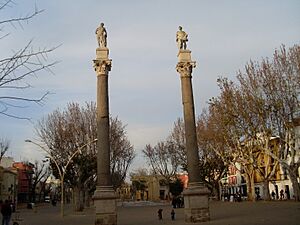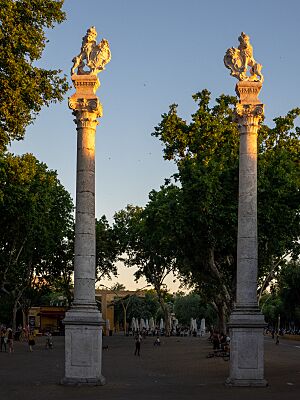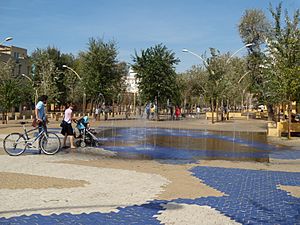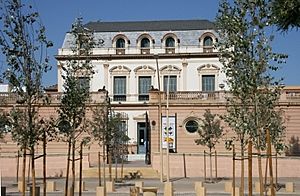Alameda de Hércules facts for kids
The Alameda de Hércules (which means Hercules Mall) is a large, open square in Seville, southern Spain. It's often just called La Alameda. This special garden square was built way back in 1574. It was designed as a public park where people could walk and enjoy nature. Its name comes from the eight rows of white poplar trees (called álamos in Spanish) that grow in its middle.
Located in the northern part of Seville's old city center (called casco antiguo), between the Guadalquivir River and the Macarena neighborhood, it was once the oldest public garden in both Spain and Europe.
History of La Alameda
Before it became the Alameda square, this area was actually part of a river branch. This branch of the Guadalquivir River used to flow through the city center. But in 1383, a dam was built, which cut off this river branch. After that, the area turned into a swampy pond. It was fed by underground water and often flooded when the river rose.
In 1574, a person called the Count of Barajas worked to drain the water from this swamp. He built special channels and added fountains. He also planted many white poplar trees along lines to create a promenade, which is a long, open space for walking. To make the promenade special, four tall columns were placed there.
Originally, they planned to use four columns from an old Roman temple nearby. People thought this temple was dedicated to Hercules. However, when they tried to move the third column, it broke! So, the project was stopped for a bit. Because of this, the two columns at the southern end of the square are truly ancient Roman columns. But the two columns at the northern end are newer copies.
To finish the project, two statues were placed on top of the two southern Roman columns. One statue is of Hercules, who is a mythical hero believed to have founded Seville. The other is of Julius Caesar, a famous Roman leader who helped rebuild the city during Roman times. Later, in the 1700s, two more statues were added to the northern columns. These statues show lions holding shields, which represent Seville and Spain.
In the late 1800s, the Alameda was a popular spot for wealthy people to meet. It had many fancy theaters and small shops called kiosks.
A big change happened in the early 2000s. The city council spent money to completely update La Alameda between 2006 and 2008. They limited car traffic, added more kiosks, benches, and fountains. The walking paths were also improved, and many new white poplar and European hackberry trees were planted. Today, La Alameda is one of the main places in Seville for fun activities in the evening.
For a long time, even with all the early improvements, La Alameda was one of the most flooded areas in the city. This continued until the mid-1900s. However, new changes to the Guadalquivir river system and a huge underground tank for rainwater have greatly improved the drainage. Now, the area doesn't flood like it used to.
Monuments and Buildings
Besides the Roman columns at the start of the promenade, there are other interesting buildings and features in La Alameda.
On the western side, you'll find the Casa de las Sirenas. This means "Mermaid's House." It's a beautiful palace built in the 1800s with a French style. Today, it's used as a community center. It hosts art shows, workshops, classes, and other cultural events for people in the neighborhood.
At the northern end of the square, there's a small church called the chapel of Nuestra Señora del Carmen y Cruz del Rodeo. This chapel is an important building in the area. It was even a source of ideas for a famous play by José Zorrilla called Don Juan Tenorio.
Also very close to the Alameda, on a street named after the Count of Barajas (who helped fix up La Alameda), is the house where the famous romantic writer Gustavo Adolfo Bécquer was born.
Nightlife and Entertainment
The Alameda neighborhood is now well-known as a lively place for evening activities in Seville. It has a fun and varied atmosphere. You can find all sorts of entertainment options in La Alameda, from live music performances to traditional Flamenco shows. Besides places to dance, there are many modern and traditional restaurants, tapas bars, cocktail bars, cafes, and even Arab-style tearooms in and around the promenade.
See also
In Spanish: Alameda de Hércules para niños





